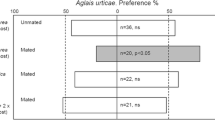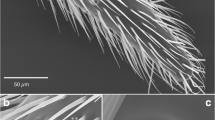Abstract
Oriented responses of Trichogramma maidisPint, et Voeg. to airborne odors were observed in a four-armed olfactometer. Experiments were carried out with odors of host eggs, the sex pheromone of Ostrinia nubilalisHbn, and maize extract, offered singly or in combination, both to naive wasps and to wasps previously exposed to the tested odor during an oviposition experience. The exploratory behavior in the olfactometer was quantified by means of a computer program which performed a space-time analysis of the insect 's movements. Whereas the naive wasps did not respond to the odor of the eggs, the synthetic sex pheromone of O. nubilalis,or the maize extract presented singly, they did react to a mixture of these three volatile cues. Prior oviposition in the odor of maize extract or in the combination of odors induced an increased preference toward the conditioning scent. This phenomenon did not occur when the wasps were conditioned to egg odor or sex pheromone alone. These results suggest that females can learn to associate some olfactory cues with the presence of the host. Immediately following the presentation of the combination of odors, a strong attraction of experienced wasps occurred; it decreased as the experiment progressed and finally reached the level presented by naive insects. Adult conditioning to the combination of odors also resulted in reduced variability in the behavioral responses.
Similar content being viewed by others
References
Altieri, M. A., Annamalai, S., Katiyar, K. P., and Flath, R. A. (1982). Effects of plant extracts on the rates of parasitization ofAnagasta kuehniella (Lep.:Pyralidae) eggs byTrichogramma pretiosum (Hym.;Trichogrammatidae under greenhouse conditions.Entomophaga 27(4): 431–438.
Arthur A. P. (1966). Associative learning inItoplectis conquisitor Say (Hym. Ichneumonidae).Can. Entomol. 98: 213–223.
Arthur, A. P. (1971). Associative learning byNemeritis canescens (Hym:Ichneumonidae).Can. Entomol. 103: 1137–1141.
Arthur, A. P. (1981). Host-acceptance by parasitoids. In Nordlund, D. A., Jones, R. L., and Lewis, W. J. (eds.),Semiochemicals: Their Role in Pest Control, John Wiley, New York, pp. 97–120.
Bar, D., Gerling, D., and Rossler, Y. (1979). Bionomics of the principal natural enemies attackingHeliothis armigera in cotton fields in Israël.Environ. Entomol. 8: 468–474.
Beevers, L., Lewis, W. J., Gross, H. R., Nordlund, J. R., and Nordlund, D. A. (1981). Kairomone and their use for management of entomophagous insects. X Laboratory studies on manipulation of host-finding behavior ofTrichogramma pretiosum with a kairomone extracted fromHeliothis zea moth scales.J. Chem. Ecol. 7(3): 635–648.
Buttery, R. G., Teranishi, R., and Ling, L. C. (1987). Fresh tomato aroma volatiles: A quantitative study.J. Agr. Food Chem. 35(4): 540–544.
Corbet, S. A. (1973). Concentration effects and the response ofNemeritis canescens to a secretion of its host.J. Insect Physiol. 19: 2119–2128.
Elzen, G. W., Williams, H. J., and Vinson, S. B. (1984). Isolation and identification of cotton synomones mediating searching behavior of parasitoidCampoletis sonorensis.J. Chem. Ecol. 10: 1251–1264.
Gardner, S. M., and van Lenteren, J. C. (1986). Characterization of the arrestment responses ofTrichogramma evanescens.Oecologia 68: 265–270.
Herard, F., Keller, M. A., Lewis, W. J., and Tumlinson, J. H. (1988). Beneficial arthropod behavior mediated by airborne semiochemicals. III. Influence of age and experience on flight chamber responses ofMicroplitis demolitor Wilkinson.J. Chem. Ecol. 14(7): 1583–1596.
Hudon, M. (1986). Un exemple de lutte rationelle contre un ravageur du maïs: La pyrale.Rev. Entomol. Quebec 31(1, 2): 23–32.
Jones, R. L., Lewis, W. J., Beroza, M., Bierel, B. A., and Sparks, A. N. (1973). Host seeking stimulant (kairomones) for the egg parasite,Trichogramma evanescens. Environ. Entomol.2: 593–596.
Kaiser, L., Pham-Delegue, M. H., Hawlitzky, N., and Masson, C. (1987). Comportement de recherche et d'oviposition deTrichogramma maïdis Pint et Voeg. (Hym.:Trichogrammatidae): Analyse quantitative en conditions contrôlées.C.R. Acad. Sci. Paris 305(III): 95–99.
Kaiser, L., Pham-Delegue, M. H., and Masson, C. (1989). Behavioral study of plasticity in host preferences ofTrichogramma maidis Pint, et Voeg.Physiol. Entomol. 14: 53–60.
Kochansky, J., Carde, R. T., Liebherr, J., and Roelofs, W. L. (1975). Sex-pheromones of the European Corn Borer(Ostrinia nubilalis) in New York.J. Chem. Ecol. 1: 225–231.
Laing, J. (1937). Host finding by insect parasites. I. Observations on finding of hosts byAlysia manducator, Mormoniella vitripennis andTrichogramma evanescens.J. Anim. Ecol. 6: 298–317.
Lecomte, C., and Thibout, E. (1984). Etude olfactométrique de l'action de diverses substances allélochimiques végétales dans la recherche de l'hôte parDiadromus pulchellus (Hym.:Ichneumonidae). Entomol. Exp. Appl.35: 295–303.
Lewis, W. J., Jones, R. L., Nordlund, D. A., and Gross, H. R. (1975). Kairomones and their use for management of entomophagous insects. II. Mechanism causing increase in rate of parasitization byTrichogramma spp.J. Chem. Ecol. 1: 349–360.
Lofdahl, K. L. (1984). A genetic analysis of habitat selection in the cactophilic species,Drosophila mojavensis. In Huettel, M. D. (ed.),Evolutionary Genetics in Insects Behavior, Plenum Press, New York.
Lupoli, R. (1985). Etude comportementale et électrophysiologique de l'attraction de la Sésamie(Sesamia nonagrioides Lef.) et de la pyrale(Ostrinia nubilalis Hbn.) par les émissions volatiles du maïs(Zea mays L.) D.E.A. Université Paris VI.
Monteith, L. G. (1963). Habituation and associative learning inDrino bohemica Mesn (Dipt.:Tachinidae):Can. Entomol. 95: 418–426.
Noldus, L. P. J. J., and van Lenteren, J. C. (1985). Kairomones forthe egg parasiteTrichogramma evanescens Westw. I. Effect of volatile substances released by two of its hosts,Pieris brassicae L. andMamestra brassicae L.J. Chem. Ecol. 11(6): 781–791.
Nordlund, D. A., Lewis, W. J., Gross, H. R. J. R., and Beevers, M. (1981). Kairomones and their use for management of entomophagous insects. XII. The stimulatory effects of host-eggs density to the effective use of kairomones forTrichogramma pretiosum.J. Chem. Ecol. 7(6): 909–918.
Nordlund, D. A., Chalfant, R. B., and Lewis, W. J. (1985). Response ofTrichogramma pretiosum females to volatile synomones from tomato plants.J. Entomol. Sci. 20(3): 372–376.
Prevost, G., and Lewis, W. J. (1987). Heritable behavior ofMicroplitis croceipes parasitoid female: Response to host kairomones.Proceedings of the 3rd European Workshop on Parasitoid Insects. Lyon, 8–10 Sept. 1987, INRA (ed.), Paris 1988 (Les Colloques d l'INRA, n∘ 48), 21–22.
Showers, W. B., Reed, J. F., Robinson, J. F., and De Rozari, M. B. (1976). Flight and sexual activity of the European Corn Borer.Environ. Entomol. 5: 1099–1104.
Siegel, S. (1956).Nonparametric Statistics for Behavioural Sciences, International Student Edition.
Strand, M. R., and Vinson, S. B. (1983). Analyses of an egg recognition kairomone ofTelenomus heliothidis (Hym.:Scelionidae). Isolation and host function.J. Chem. Ecol. 9(3): 423–432.
Tabashnik, B. E., Weelock, H., Rainbolt, J. D., and Watt, W. B. (1981). Individual variation in oviposition preference in the butterfly,Colias eurytheme.Oecologia 50: 225–230.
Taylor, R. J. (1974). Role of learning in insect parasitism.Ecol. Monogr. 44: 89–104.
Thompson, A. C., Roth, J. P., and King, E. G. (1983). Larviposition kairomone of the tachinidLixophaga diatraea.Environ. Entomol. 12(5): 1312–1314.
Thorpe, W. H. (1956). Arthropods. InLearning and Instinct in Animals, Methuen, London, PartIII, Chap. XI, pp. 203–259.
van Alphen, J. J. M., and Vet, L. E. M. (1986). An evolutionary approach to host-finding and selection. In Waage, J., and Greathead (eds.),Insect Parasitoids, Academic Press, London, pp. 23–61.
Vet, L. E. M. (1983). Host habitat location through olfactory cues byLeptopilina claviceps Hartig (Hym.:Eucoilidae), a parasitoid of fungivorous Drosophila: The influence of conditioning.Neth. J. Zool. 33(3): 225–248.
Vet, L. E. M., and van Opzeeland, K., (1984). The influence of conditioning on olfactory microhabitat and host location inAsobara tabida Nees andA. rufescens Foerster (Braconidae Alysiinae), larval parasitoids ofDrosophilidae.Oecologia 63: 171–177.
Vet, L. E. M., van Lenteren, J. C., Heymans, M., and Meelis, E. (1983). An airflow olfactometer for measuring olfactory responses of hymenopterous parasitoids and other small insects.Physiol. Entomol. 8: 97–106.
Vinson, S. B. (1976). Host selection in insect parasitoids.Annu. Rev. Entomol. 21: 109–133.
Vinson, S. B. (1981). Habitat location. In Nordlund, D. A., Jones, R. L., and Lewis, W. J. (eds.),Semiochemicals: Their Role in Pest Control, John Wiley, New York, pp. 51–78.
Voegele, J., Stengel, M., Schubert, G., Daumal, J., and Pizzol, J. (1975). Les Trichogrammes. V (a). Premiers résultats de l'introduction en Alsace sous forme de lâchers saisonniers de l'écotype moldave deTrichogramma evanescens Westwood contre la pyrale du maïs,Ostrinia nubilalis Hbn.Ann. Zool. Ecol. Anim. 7: 535–551.
Weseloh, R. M. (1981). Host location by parasitoids. In Nordlund, D. A., Jones, R. L., and Lewis, W. J. (eds.),Semiochemicals: Their Role in Pest Control, John Wiley, New York, pp. 79–96.
Zaborski, E., Teal, P. E. A., and Laing, J. E. (1987). Kairomone-mediated host finding by spruce budworm egg-parasite,Trichogramma minutum.J. Chem. Ecol. 13(1): 113–122.
Author information
Authors and Affiliations
Rights and permissions
About this article
Cite this article
Kaiser, L., Pham-Delegue, M.H., Bakchine, E. et al. Olfactory responses ofTrichogramma maidis Pint, et Voeg.: Effects of chemical cues and behavioral plasticity. J Insect Behav 2, 701–712 (1989). https://doi.org/10.1007/BF01065787
Accepted:
Issue Date:
DOI: https://doi.org/10.1007/BF01065787




